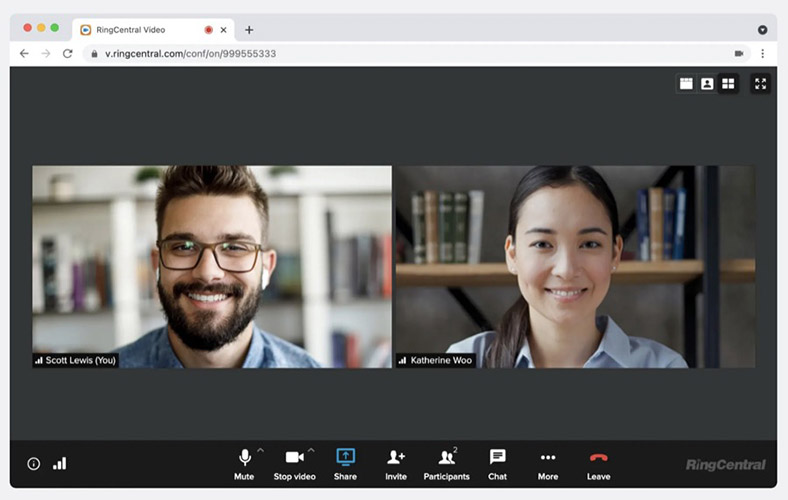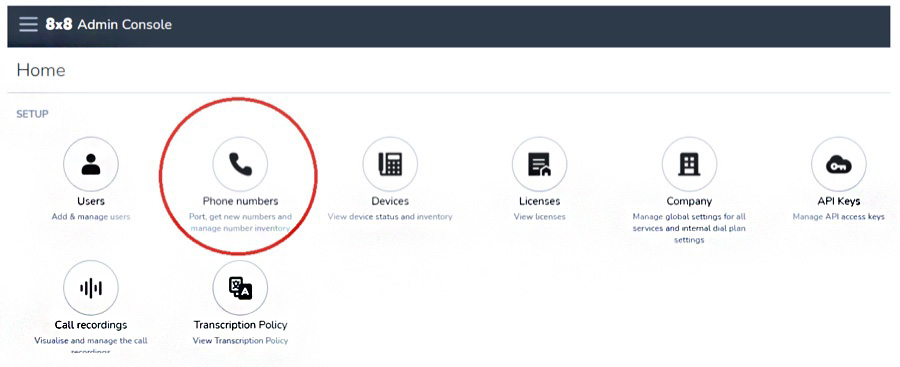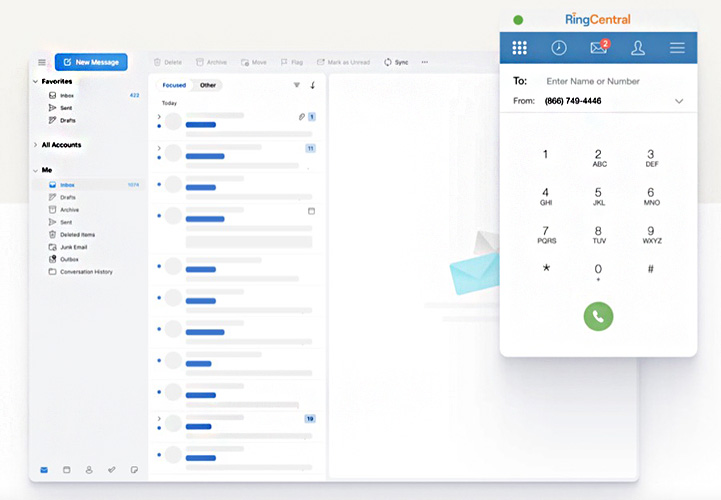RingCentral is a business phone system that offers extensive app integrations and advanced video conferencing functionalities. On the other hand, 8×8 shines by providing video conference capacity for more than 200 people and a high volume of international calls. We compared RingCentral vs 8×8—both unified communications (UC) platforms—to determine which option fits your business needs.
Based on our comparison, the best use cases for 8×8 X Series vs RingCentral MVP (Message, Video, Phone) are as follows:
- RingCentral: Better for businesses needing a scalable unified communications as a service (UCaaS) phone system with advanced team collaboration tools
- 8×8: Better for companies looking for a UCaaS platform with global reach and large video conferencing
RingCentral vs 8×8 at a Glance
RingCentral vs 8x8 Pricing & Plans | ||
|---|---|---|
Monthly Starting Price (per User) | $32.99 | $15 |
Free Trial | 14 days | 30 days |
High-definition Audio & Video Conferencing | Up to 500 participants | Up to 200 participants |
Unlimited Domestic Calling (U.S. & Canada) | ✓ | ✓ |
International Calling | Unlimited calls to up to 48 countries | Pay-per-minute fees |
Integrations | Over 200 | 60 |
Internet Fax | Unlimited | Unlimited |
Multi-level Auto-attendant | ✓ | ✓ |
Customer Support | 24/7 | 24/7 |
For More Information |
Get a closer look at RingCentral and 8×8 as unified communication solutions in our in-depth RingCentral review and 8×8 review.
Best Alternatives
While 8×8 X Series and RingCentral MVP are excellent options for small businesses needing a robust VoIP phone system or full UCaaS tech stack, freelancers or startup duos may find the robust systems overkill. Other options or add-on packages are available at lower prices for better plan customizations.
A few of the best 8×8 and RingCentral alternatives include the following:
- Nextiva: Check out Nextiva if you’re looking for volume-based discounts, screen call pops, and unlimited internet fax. Monthly plans also come with toll-free minutes like RingCentral.
- Grasshopper: Solopreneurs and small teams may prefer a virtual phone system that doesn’t charge per user. While Grasshopper doesn’t offer UCaaS features like video conferencing or team chat, you still get popular features like an auto-attendant. Plus, you can save a lot of money by assigning team members extensions instead of individual phone numbers.
- Ooma: With residential packages, Ooma is a business phone system suited for solopreneurs and freelancers working from home who need a free, scalable VoIP solution.
Best for Pricing: 8×8
Monthly Plans* (per User)
| Monthly Plans** (per User)
|
*Users are allowed to mix and match plans and save up to 25% with annual billing.
**Quote is based on one to 20 users and saves up to 40% with annual billing.
8×8 takes first place in pricing because its base plan (Express) is less than half the price of RingCentral MVP’s entry-level plan (Essentials). Both RingCentral and 8×8 offer annual billing. However, even with RingCentral’s higher offer of 40% annual savings, its discounted base plan comes in at $19.99, which is still more expensive than 8×8 ($15).
8×8’s base plan comes with video conferencing, a feature lacking in RingCentral’s entry-level plan. 8×8’s X2 offers up to 500 video conferencing participants, much higher than RingCentral’s maximum of 100 people in its Standard plan. Users can also mix and match X Series plans to pick cheaper packages for standard users and more expensive packages for supervisors, allowing you to potentially save on costs over time.
Best for Video Conferencing: RingCentral
RingCentral offers unlimited audio conferencing and high-definition (HD) video conferencing. Group video conferencing has no time limitations and supports up to 200 participants. | All subscriptions include unlimited one-to-one or group video conferencing. Higher tiers accommodate up to 500 participants with screen sharing, advanced moderator controls, and virtual backgrounds. |
Based on in-depth analysis, RingCentral offers more advanced interactive video conferencing features while offering a smaller maximum capacity in conferences than 8×8. Both providers have screen sharing, one-on-one, group chat, HD video, and audio functionalities. However, RingCentral MVP’s video meetings use artificial intelligence (AI) to create meeting summaries and filter out unwanted background noise, such as lawnmowers, keyboards, and animal barks.

Join meetings instantly on RingCentral’s browser-based video meetings. (Source: RingCentral)
RingCentral’s glassboard mode moves your video image anywhere on the screen during a presentation or using a conference background. This makes it look like you’re projecting your slides onto a display. Also, its Team Huddle feature creates a virtual workspace where colleagues can come and go as needed.
On the other hand, if you need to host conferences with more than 200 participants, 8×8 is ideal. Its HD audio and video conferencing have screen-sharing capabilities for up to 500 active participants.
Best for Team Collaboration: RingCentral
Team messaging with multi-channel contact history, calendar sharing, task and file management, and file search. RingCentral offers up to 100 hours of call recording storage. | Offers 1:1 team messaging channels (Rooms) accessible on any device. 8x8 offers unlimited media storage. |
RingCentral MVP and 8×8 X Series enable distributed teams to work together on projects using their preferred devices, and both platforms offer similar feature sets. RingCentral provides personal folders for files, task assignment, and screen sharing, all secured with dynamic end-to-end encryption. RingCentral is great for large internal audio conferences because it can host up to 1,000 people, whereas 8×8’s voice meetings are restricted to 500 attendees.
While 8×8 plans include unlimited media storage, allowing you to securely store shared documents, images, and videos in the cloud, our 8×8 vs RingCentral comparison shows 8×8 is better for external communications. Its analytics and range of customer relationship management (CRM) systems are ideal for high volumes of inbound calls. RingCentral is better for collaboration, thanks to its call transcripts, custom teams, and department setups.
Best for International Calling: 8×8
Unlimited international calls to 14 or 48 countries, depending on the plan. Public switched telephone network (PSTN) services are available in over 55 countries. | Per-minute fees are charged for calls from the U.S. or Canada to other countries. Local PSTN support in over 45 countries. |
8×8 is the clear winner for international calling. Its subscriptions come with unlimited, free, international calling to two different calling zones; X2 users can call 14 countries, while users on X4 plans and higher make free calls to 48 regions like Finland, Greece, and India. RingCentral charges per-minute fees for calls made outside of the U.S. and Canada.
Businesses with a global employee or client base with high calling requirements will see substantial savings with the X Series plan’s unlimited calling versus other metered plans, including unlimited, free extension-to-extension calls plus free calls to any other 8×8 Work user anywhere in the world. For more information, see 8×8′s International Calling page.

User’s admin console in the 8×8 application panel. (Source: 8×8)
Best for Integrations: RingCentral
Offers nearly 300 integrations, including top customer relationship management (CRM) platforms Zoho, Salesforce, and HubSpot. | 60 integrations with top platforms, such as Salesforce, Google Workspace, and NetSuite. |
RingCentral connects your UCaaS platform to over 200 third-party applications, compared to 8×8 X Series plans that only support 60. All integrations are available in 8×8’s cheapest plan, but it’s far fewer than what’s available with RingCentral. Even though many of RingCentral’s integrations are locked behind higher-tier plans, basic integrations with calendar tools, such as Google Workspace and Microsoft 365, are included in the standard plan.

Enhance your phone system by linking your Microsoft apps. (Source: RingCentral)
Connecting Zapier and RingCentral means automatically receiving notifications for missed calls, messages, or spreadsheet updates automatically to your platform of choice. A premium plan subscription gives users access to CRM compatibility and a host of operational or industry-specific integrations.
Discover the top RingCentral integrations in our comprehensive guide to find out if your preferred tools and apps are compatible with RingCentral’s platform.
Best for Call Management: RingCentral
Key features include agent and call monitoring, overflow call queues, automatic call distribution, interactive voice response, and visual voicemail. | Includes music on hold and basic auto-attendant in its base plan. It also offers multi-level auto-attendant, extensive call recording, and voicemail transcription. |
Based on our 8×8 X Series vs RingCentral MVP comparison, both providers offer essential features from a unified communications (UC) provider, such as intelligent auto-attendant, voicemail, and skills-based routing. RingCentral comes out on top because of its advanced call solutions, such as visual voicemail and overfall call queues, that enable businesses to stay connected with colleagues and customers easily.
RingCentral allows users to configure their phone system and optimize communications using custom admin and user configurations. This lets you determine answering rules, real-time presence, and call transfer and forwarding. RingCentral offers spam prevention and your choice of 57 call analytics apps, which 8×8 does not.
Frequently Asked Questions (FAQs)
Are emergency calls allowed on RingCentral & 8×8?
Yes, both RingCentral and 8×8 offer emergency call services. Looking at 8×8 vs RingCentral, the X series and Express plan holders have access to 911 emergency services. RingCentral users can call either 000/112 emergency services in times of need.
How secure are RingCentral & 8×8?
RingCentral uses a mix of security strategies, including seven layers of security and redundant data centers for optimal user protection and high availability. 8×8, on the other hand, focuses on 10 certifications and standards, starting with NIST 800-53, the gold standard for security controls, and Advanced Encryption Standard (AES) 256.
Do RingCentral & 8×8 offer toll-free numbers?
Yes, both RingCentral MVP and 8×8 X Series plans offer toll-free numbers. RingCentral also supplies users with toll-free minutes on all calling plans, whereas none of the 8×8 plans includes toll-free minutes.
Pro tip: Many business phone systems like RingCentral offer free 800 numbers as part of their monthly subscriptions. Read more about how to get an 800 number for your business in our detailed guide.
How We Evaluated 8×8 vs RingCentral
We looked at free and paid plans from RingCentral vs 8×8 to discover how the packages compare. We also tested each software and checked user feedback on popular review websites. From there, we created a scoring system based on the following categories: pricing, video meeting capabilities, collaboration features, ease of use, integrations, and security.
Here’s a complete breakdown of the factors used in comparing 8×8 vs RingCentral:
Bottom Line
In this RingCentral vs 8×8 head-to-head comparison, RingCentral is the clear winner with its robust third-party integrations, video conferencing capabilities, and advanced call management features. 8×8 is better for home offices and smaller teams that want to unlock as many features as possible at a lower monthly price. It’s also recommended for teams engaged in international calling.